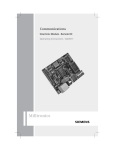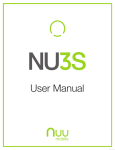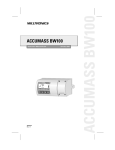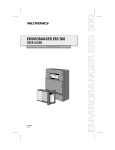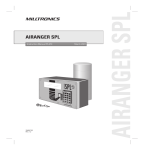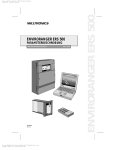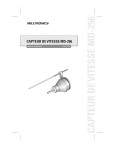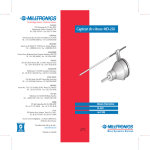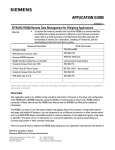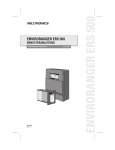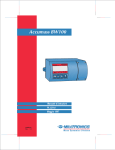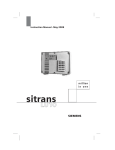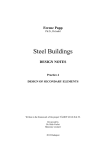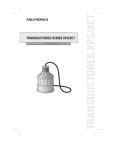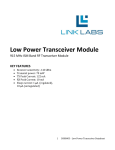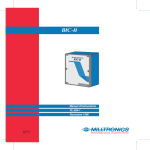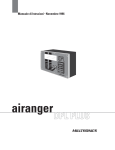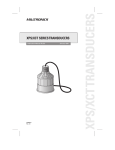Download Siemens Milltronics SmartLinx Allen
Transcript
FOR ALLEN-BRADLEY REMOTE I/O Instruction Manual PL-533 April 2001 R 33455330 Rev. 3.1 SMARTLINX INTERFACE MODULE SMARTLINX INTERFACE MODULE Safety Guidelines Warning notices must be observed to ensure personal safety as well as that of others, and to protect the product and the connected equipment. These warning notices are accompanied by a clarification of the level of caution to be observed. Qualified Personnel This device/system may only be set up and operated in conjunction with this manual. Qualified personnel are only authorized to install and operate this equipment in accordance with established safety practices and standards. Warning: This product can only function properly and safely if it is correctly transported, stored, installed, set up, operated, and maintained. Note: Always use product in accordance with specifications. Copyright Siemens Milltronics Process Instruments Inc. 2000. All Rights Reserved Disclaimer of Liability This document is available in bound version and in electronic version. We encourage users to purchase authorized bound manuals, or to view electronic versions as designed and authored by Siemens Milltronics Process Instruments Inc. Siemens Milltronics Process Instruments Inc. will not be responsible for the contents of partial or whole reproductions of either bound or electronic versions. While we have verified the contents of this manual for agreement with the instrumentation described, variations remain possible. Thus we cannot guarantee full agreement. The contents of this manual are regularly reviewed and corrections are included in subsequent editions. We welcome all suggestions for improvement. Technical data subject to change. MILLTRONICS®is a registered trademark of Siemens Milltronics Process Instruments Inc. Contact SMPI Technical Publications at the following address: Technical Publications Siemens Milltronics Process Instruments Inc. 1954 Technology Drive, P.O. Box 4225 Peterborough, Ontario, Canada, K9J 7B1 Email: [email protected] For the library of SMPI instruction manuals, visit our Web site: www.milltronics.com © Siemens Milltronics Process Instruments Inc. 2001 Table of Contents Table of Contents .................................................................................. 3 Specifications ........................................................................................ 5 About SmartLinx Remote I/O… ............................................................ 7 About this Manual… ......................................................................... 7 About this Module… ......................................................................... 8 Installation.............................................................................................. 9 Compatibility..................................................................................... 9 Cable Connector ............................................................................ 11 Operation.............................................................................................. 13 Communications Setup ...................................................................... 15 Recommendations ......................................................................... 15 Specific Parameters ....................................................................... 16 Application Layer ................................................................................ 19 Parameter Indexes ......................................................................... 19 Data Access Methods .................................................................... 21 Data Map – Level Products ............................................................ 24 Data Map – Mass Dynamics Products ........................................... 36 Data Types ..................................................................................... 45 Troubleshooting .................................................................................. 49 Generally ........................................................................................ 49 Specifically ..................................................................................... 49 Index ..................................................................................................... 53 PL-533 SmartLinx A-B Remote I/O Page 3 Page 4 SmartLinx A-B Remote I/O PL-533 Specifications PL-533 SmartLinx A-B Remote I/O Page 5 Specifications Application: • compatible with master devices on an Allen-Bradley Remote I/O bus Compatible Instruments: Level • AiRanger XPL Plus • AiRanger DPL Plus • AiRanger SPL • CraneRanger • InterRanger DPS 300 • EnviroRanger ERS 500 Mass Dynamics • Accumass BW500 Communication Settings: baud rate: • 57.6, 115.2, or 230.4 Kbaud starting group: • ¼ to full rack rack size: • ¼ to full rack Connection: • 3-position terminal block for wire end Termination: • switch selectable, open or 82 Ω internal Cable: • Belden 9463 “Blue Hose” or equivalent Specifications Page 6 SmartLinx A-B Remote I/O PL-533 About SmartLinx Remote I/O… About this Manual… This manual is intended to provide the user with the information required to ® successfully install and connect a Milltronics SmartLinx Allen-Bradley Remote I/O module and set it up for communication within a Remote I/O network. The module name is shortened to SmartLinx A-B Remote I/O for the rest of this manual. ® Remote I/O is an industry standard protocol owned by Allen-Bradley which is part of Rockwell Automation. For a full description of the Remote I/O protocol, contact Rockwell or visit their web site at www.rockwell.com. Note: Milltronics does not own the Remote I/O protocol. All information regarding that protocol is subject to change without notice. PL-533 SmartLinx A-B Remote I/O Page 7 About Remote I/O This manual is targeted at a technical audience in the industrial communications field with a sound working knowledge of Remote I/O. About this Module… The Milltronics SmartLinx module for Allen-Bradley Remote I/O is a plug-in communications card designed to interface a Milltronics SmartLinx compatible instrument to an Allen-Bradley Remote I/O network. Only those instruments which support the SmartLinx Allen-Bradley Remote I/O card can use this card. See Compatibility on page 9 for a list of compatible host instruments. About Remote I/O Allen-Bradley PLC Remote I/O bus Milltronics Instruments Page 8 SmartLinx A-B Remote I/O PL-533 Installation The SmartLinx card is either shipped installed in the host instrument or separately for on-site installation. Refer to the Milltronics host instrument manual for details on module location and physical installation. Compatibility All available SmartLinx card configurations are shown here for reference. • • • • • AiRanger XPL Plus AiRanger DPL Plus AiRanger SPL CraneRanger InterRanger DPS 300 module connector (underside) to Milltronics host instrument mounting hole Installation mounting hole reserved switches status LEDs cable connector PL-533 termination switch SmartLinx A-B Remote I/O Page 9 • EnviroRanger ERS 500 • Accumass BW500 EnviroRanger Rack or Panel mounting hole mounting hole termination switch Installation module connector (underside, 10-pin) reserved switches status LEDs EnviroRanger Wallmount and Accumass BW500 mounting hole mounting hole reserved switches cable connector termination switch status LEDs Notes: • • Page 10 Install the SmartLinx card so that the mounting holes align and the pin connectors will mate correctly. You’ll find that the module connectors have room for two more pins than are found on the card. Correct cable routing is important for electromagnetic noise suppression. Follow the routing instructions contained your unit’s instruction manual. SmartLinx A-B Remote I/O PL-533 Termination Switch Termination Setting open (not used) off 150 Ω (use external resistor)* off 82 Ω on Switch Position See Cable Connector, below for resistor placement Use the onboard 82 Ω for 230.4 kbps or an external 150 Ω for 57.6 or 115.2 kbps. Using 150 Ω termination will limit the number of physical devices on your network to 16. Refer to your PLC User Manual for information on selecting the baud rate, cable type, maximum cable length, and termination resistor values for your installation. Installation Reserved Switch All dip switches must be set “on.” on off Cable Connector Connect using Belden 9463 “Blue Hose” cable or equivalent and terminate (blue/clear) according to Allen-Bradley specification and conventions. AiRanger Series, CraneRanger, InterRanger DPS 300 150 Ω termination resistor (if required) clear terminal block number 3 cable colour blue 2 shield 1 clear shield blue PL-533 SmartLinx A-B Remote I/O Page 11 EnviroRanger ERS 500 (Rack or Panel Mount) When using a SmartLinx card with the EnviroRanger all wiring is made to the EnviroRanger terminal board. The Remote I/O connections map to the EnviroRanger terminal board as shown: EnviroRanger 65 66 69 Connection Blue Clear Shield EnviroRanger ERS 500 (Wall Mount) and Accumass BW500 150 Ω termination resistor (if required) clear terminal block number 3 cable colour blue 2 shield 1 clear Installation shield blue Page 12 SmartLinx A-B Remote I/O PL-533 Operation Communication on the Remote I/O link is indicated by the SmartLinx LEDs. on – module is powered on – active communication off – no communication between bus and module green amber red flash – bus intact: Allen-Bradley PLC in program, or Milltronics host instrument set to different rack size than PLC on – not being scanned by PLC Operation PL-533 SmartLinx A-B Remote I/O Page 13 Operation Page 14 SmartLinx A-B Remote I/O PL-533 Communications Setup Host instruments use parameters to configure the SmartLinx card. Parameters values may be entered into the instrument with a hand-held programmer, or by using Milltronics' Dolphin Plus PC software. Note: Some parameters used for SmartLinx are similar to those that are used for other functions in the host instrument. Ensure that you change the correct ones (P751 to P755) to configure the SmartLinx card. For example: P772 on some host instruments is the Baud Rate of the built in communications ports. Do not confuse that parameter with P751, which is the Baud Rate of the SmartLinx A-B Remote I/O card. Recommendations The following are recommendations about how to configure the Milltronics instrument on the Remote I/O network. Other configurations are possible but these have been found to provide the best operation. Rack Size Set up the Milltronics host instrument as a 1/4 rack size to conserve remote rack space available to the PLC. As discrete I/O operation is very limited when using 1/4 rack size configuration, block transfer read and write commands (see page 19) are recommended. Communication Type If you are using an Accumass BW500, then you have to use Block Transfers. However, if you are using a level product then you have a choice between using Discrete I/O method and Block Transfer Method. Generally, Block Transfers are the better way to go, since more data is available to you. However, if you are using a SLC500 and only want the level information, the Discrete I/O is definitely the easiest method. Exercise caution when deciding how often to trigger the Block Transfer Read (BTR) and Block Transfer Write (BTW) instructions. Triggering too often increases the delay of all block transfers on the Remote I/O link. The recommended guideline is to trigger the BTR and BTW instructions no faster than every 0.3 seconds. PL-533 SmartLinx A-B Remote I/O Page 15 Communications Setup BTR and BTW Timing Note: Shipped with the SmartLinx A-B Remote I/O card, is a diskette containing some program examples for a PLC5 and SLC500. Specific Parameters These parameters are set on the host instrument. The SmartLinx card must be installed before they are accessible. Consult the host instrument’s manual for instructions on programming. “f” indicates the factory preset. P751 Baud Rate Sets the baud rate for Remote I/O communication between the Milltronics host instrument and the Allen-Bradley PLC. Set this parameter to match the baud rate used by all devices on the RIO bus. Values 0 1 2 f 57.6 Kbaud 115.2 Kbaud 230.4 Kbaud P752 Rack Number Sets the rack number (octal) that the Milltronics host instrument has been assigned on the Remote I/O link. Check your PLC manual for the supported range. Values 01 to 73 Preset: 2 Communications Setup P753 Starting Group Sets the starting group number for the Milltronics host instrument. Values 0 f 2 4 6 Page 16 Rack Size (see P754) ¼, ½, ¾ or full ¼, ½ or ¾ ¼ or ½ ¼ SmartLinx A-B Remote I/O PL-533 P754 Rack Size Sets the discrete I/O address space. Valid settings are 1 to 4 quarter racks, dependent upon the starting group (P753). Values 1 2 3 4 Rack Size f ¼ ½ ¾ full Starting Group (P753) 0, 2, 4 or 6 0, 2 or 4 0 or 2 0 P755 Last Rack Indicates if the Milltronics host instrument is on the last rack. The last rack is defined as the highest numbered rack on the Remote I/O link. Value 0 1 f not last last Communications Setup PL-533 SmartLinx A-B Remote I/O Page 17 Communications Setup Page 18 SmartLinx A-B Remote I/O PL-533 The application layer describes the organization and format of data that an Allen-Bradley PLC can access. Allen-Bradley has defined two different methods through which the host instrument can access data Block Transfer This method is used to pass a large amount of data from the remote instrument to the PLC. This method is recommended. Discrete I/O This was the original method for passing data in remote I/O. Using this method, the Milltronics instrument would look like a remote I/O rack to the AB PLC. If you are using a level instrument and just want a few levels, then this method works fine. If you have a weigh feeder then this method is not supported because there is too much data to be passed. Page Reference Discrete I/O Block Transfer For information on the application layer for each supported instrument refer to page shown. Level Products 24 31 Mass Dynamics Products 36 N/A For a description of the parameter values, see Data Types on page 45. For a description of the parameters themselves, refer to the manual for the host instrument. Parameter Indexes Most parameters used on host instruments are indexed. Indexing allows a parameter to relate to more than one input or output. For example, many parameters are indexed by measurement point while others are indexed by relay or discrete input. An index that relates to an input or output is called a Primary Index. PL-533 SmartLinx A-B Remote I/O Page 19 Application Layer Application Layer Application Layer Example of a primary index is: P111[3] = “52” means: P111 (Relay Control Function) for relay 3 is set to “52” 52 Sometimes a parameter requires a second index to allow for multiple values on an indexed input or output. For example a measurement point which calculates a reading on volume can require characterization breakpoints. These breakpoints are given on a secondary index (the primary index relates to the transducer input). An index that relates to a previously indexed parameter is called a secondary index. Example of a secondary index is: P054[1,5] = “1.6m” means: P054 (Breakpoint Levels) for breakpoint 5 on transducer 1 is set to 1.6m 1.6m The way that indexes are handled in the memory map depend on the data access method used. See Data Access Methods, below. Page 20 SmartLinx A-B Remote I/O PL-533 Data Access Methods Direct Access Certain values are mapped directly into words. These words can be read at any time. Multiple Parameter Access (MPA) Note: MPA is used on Level products only. This is a hand-shaking method where the user tells the Parameter number, secondary index, decimal place, and format, then the SmartLinx module will write into a certain area all 10 primary indexes of that parameter. (Recall that in Milltronics’ products, the memory is arranged as Parameter number, Primary Index, Secondary Index). Using Multiple Parameter Access (MPA) 1. In the output table of the PLC (Write Block) write the values for the parameter number, secondary Index, decimal place and format in the correct location. 2. Monitor the Input table of the PLC (Read Block), and watch for the values you wrote to appear in the appropriate locations of the read block, then go to Step 3. 3. Read the requested values in the appropriate location of the Read Block. These values are continuously updated. Continue reading from these words until values for another parameter are required. At that time, go back to step 1. Parameter Indexing with MPA Primary Index The primary index is implicit in the memory address read. MPA values are returned through words 21 to 30 of the read block. Secondary Index The secondary index is nearly always left at zero. See the manual for the Milltronics SmartLinx instrument for information on parameters, including which require a secondary index. PL-533 SmartLinx A-B Remote I/O Page 21 Application Layer There are three different methods used in the memory mapping to give the users access to the SmartLinx Instrument parameter table. They are: Application Layer Single Parameter Access (SPA) Note: SPA is used on both Level and Mass Dynamics products. This is a hand-shaking method where the user tells the Parameter number, Primary Index, Secondary Index, decimal place, format, read/write flag, value, then the SmartLinx module either reads or writes the value. With this method any value in the Milltronics product can be read or written. Using Single Parameter Access (SPA) Words 5 to 12 are used for SPA, allowing continuous monitoring or demand programming of a parameter for a given indexed measurement point, individually selected for each point. Reading a Parameter 1. Set the Read/Write flag in the output table (Write Block) to 0, “read”. 2. Write the Parameter Number, Primary Index, Secondary Index, Decimal Place and Format in the correct locations. Note If there is no secondary index, then place a 0 in this location. 3. Monitor the Input table of the PLC (Read Block) and watch for the values you wrote to appear in the appropriate locations, then go to Step 4. 4. Read the requested parameter value in the Input table (Read Block). These values are continuously updated. Continue reading from these words until values for other parameters are required. At that time, go back to step 1. Writing a Parameter 1. Set the Read/Write flag in the output table (Write Block) to 0, “read”. 2. Write the Parameter Number, Primary Index, Secondary Index, Decimal Place and Format in the correct locations. 3. Write the new value of the parameter into the correct location of the output memory (Write Block) 4. Verify the unit is in program mode (not needed for BW500). For Level see bit 10 of status word in Read Block. Page 22 SmartLinx A-B Remote I/O PL-533 If it is not in program mode, write a 1 to the operating mode word in the output memory (Write Block). Please note that this will only work if the word is already a 0 (ie. it only works as a transition). 6. Set the Read / Write flag in the output table (Write Block) to a 1 “write”. 7. Monitor the Input table of the PLC (read block) and watch for the values you wrote to appear in the appropriate locations. 8. Set Read / Write flag back to 0. 9. Place unit in Run mode. Note (does not apply to Accumass BW 500): Parameters can only be written in Program mode (word 12 = 1). If the host instrument is still in Run mode then any written values are ignored. PL-533 SmartLinx A-B Remote I/O Page 23 Application Layer 5. Application Layer Data Map – Level Products The data maps allow for up to 10 indexed measurement points. If your host instrument has fewer than 10 points then ignore data in registers that represent unused or non-existing points. Note: Registers referenced to unused measurement points will be readable but will contain undefined values. Level Products – Block Transfers This section describes the meaning of the data read from and written to the Milltronics host instrument in block transfer mode. Note: Parameter P999 (Master Reset) is not accessible through the SmartLinx interface on level products. Refer to the Allen-Bradley PLC documentation on how to program block transfer read (BTR) and block transfer write (BTW) rungs in your PLC ladder logic. Memory Map Word Description Access Data Type 0 measurement point on priority direct bitmapped 1 parameter number 2 parameter secondary index1 integer 3 decimal place 4 format 0/1 5 parameter number integer 6 parameter primary index integer 7 parameter secondary index integer 8 parameter value 9 decimal place integer 10 format 0/1 11 read/write flag 0/1 12 operating mode MPA SPA direct integer integer integer 0/1 Note: See previous section for definitions of SPA, MPA and direct. 1 The primary index is implicit in the address of the returned parameter values. Page 24 SmartLinx A-B Remote I/O PL-533 BTW Word 0, Point-on-Priority Point-on-Priority is only used when the host instrument is an AiRanger XPL Plus. Bits 00-09 set the priority status of corresponding indexed points 1-10. These index values, 1 to 10, correspond to the measurement points on the host instrument. bit 09 08 07 06 05 04 03 02 01 00 point 10 9 8 7 6 5 4 3 2 1 bit status 0 = normal 1 = priority In the example: bit 09 08 07 06 05 04 03 02 01 00 point 0 0 0 0 0 0 0 1 0 1 Measurement points 3 and 1 are on priority scan. Bits 10 to 15 are reserved and contain 0. This word is ignored if the Milltronics host instrument is configured as a full rack (P754 Rack Size set to 4). In that case, use discrete output word 7 to control point-on-priority. If this word is used to control point-on-priority, then the Milltronics host instrument must be configured to permit this. Parameter P720 must be set to 1 (manual, BIC-II or SmartLinx) for each point to permit priority control for that point. To enable priority control for all points, store “1” to parameter P720, point “0.” BTW Word 1: Parameter Number, MPA Specifies the parameter number for the returned value in BTR words 21-30. See Block Read on page 28. BTW Word 2: Parameter Secondary Index, MPA Specifies the parameter secondary index for the parameter returned in BTR words 21-30. This word is ignored for parameters which don’t use a secondary index. PL-533 SmartLinx A-B Remote I/O Page 25 Application Layer Note: Application Layer Some specific Milltronics host instrument parameters use a secondary index to address the multiple values stored within the single parameter. See Parameter Indexes on page 19 for more information. Note: The Primary Index is implicit in the word location where word 21 = index 1 and 30 = index 10. BTW Word 3: Decimal Place, MPA Specifies the number of decimal places that the returned values are shifted. This affects BTR words 21-30. Positive values indicate that the decimal place shifts to the left. i.e. A 1 means that all returned values have the decimal place shifted 1 space to the left and a returned value of 5,213 is interpreted as 521.3. Negative values indicate that the decimal place shifts to the right. i.e. for example if this word is -1, a returned value of 5,213 is interpreted as 52,130. BTW Word 4: Format, MPA Sets the format for the returned values in BTR words 21 - 30. bit status 0 = normal 1 = percent BTW Word 5: Parameter Number, SPA Specifies the parameter number. BTW Word 6: Parameter Primary Index, SPA Specifies the primary index number for the parameter specified by BTW word 5. See Parameter Indexes on page 19 for more information. BTW Word 7: Parameter Secondary Index, SPA Specifies the secondary index for the parameter specified by BTW word 5. This word is ignored for parameters that don’t use multiple indexes. See Parameter Indexes on page 19 for more information. Page 26 SmartLinx A-B Remote I/O PL-533 BTW Word 8: Value, SPA BTW Word 9: Decimal Place, SPA This word specifies the number of decimal places for the value in BTW word 8, and also for the parameter value returned in BTR word 38. Positive values indicate that the decimal place shifts to the left. i.e. A 1 means that all returned values have the decimal place shifted 1 space to the left and a returned value of 5,213 is interpreted as 521.3. Negative values indicate that the decimal place shifts to the right. i.e. for example if this word is -1, a returned value of 5,213 is interpreted as 52,130. BTW Word 10: Format, SPA This word sets the format for the value in BTW word 8. bit status 0 = normal 1 = percent BTW Word 11: Read/Write Flag, SPA This word instructs the read/write application of word 8. bit status 0 = read parameter as described by words 5, 6, 7, 9 and 10; word 8 ignored 1 = set parameter to the value described by words 5-10 BTW Word 12: Operating Mode, SPA This word sets the operating mode of the Milltronics host instrument. The host instrument changes mode only when the status of the bit changes. The operating mode is also set via the host instrument keypad. bit status 0 = run mode 1 = program mode PL-533 SmartLinx A-B Remote I/O Page 27 Application Layer This word contains the value to be written to the parameter specified by BTW words 5-7, if BTW word 11 is set to 1. If BTW word 11 is set 0, this word is ignored. The format of this word is specified by BTW words 9-10. Application Layer Block Read Values in words 0 to 20 are directly available, no write operation is required to request them. Values in words 21 to 41 are determined by the write operation that requested them, either MPA or SPA. See Level Products – Block Transfers on page 24. Words Description 0 measurement point status Access 1-10 measurement point reading 11-20 measurement point alarm / status 21-30 parameter returned values integer 31 decimal place integer direct format 33 parameter number integer bitmapped MPA 32 Data Type bitmapped 0/1 integer 34 parameter secondary index integer 35 parameter number integer 36 parameter primary index integer 37 parameter secondary index 38 parameter returned value integer 39 decimal place integer 40 format 0/1 41 read/write flag 0/1 SPA integer BTR Word 0: Measurement Point Status Bits 00 to 09 – Point Status Indicates the operation of measurement points 1-10. bit 09 08 07 06 05 04 03 02 01 00 index 10 9 8 7 6 5 4 3 2 1 If a bit status is 0, the corresponding point is deemed to be operational, based on the criteria defined by BTR words 11-20, bits 00-03. If the bit status is 1, then the corresponding point is deemed non-operational. To further diagnose a point’s operation, examine the corresponding word 11 through 20. If a bit status is 1, then for the corresponding point alarm word 11-20, one or more of the alarm bits 00-03 must be 1 to indicate the operational problem. Bit 10 – operating mode 0 = host instrument in “run” mode 1 = host instrument in “program” mode Page 28 SmartLinx A-B Remote I/O PL-533 Bits 11 to 15 – Reserved BTR Words 1-10: Point Reading These words contain the value of parameter P920 (Reading) for points 1-10, respectively. The reading is expressed as a percent of full scale, multiplied by 100, giving a range of –20,000 to 20,000 which corresponds to -200.00% to 200.00%. Refer to the Milltronics host instrument documentation for a definition of “P920”. Note: These values may contain numeric level data for inoperative or malfunctioning points; refer to BTR word 0, and BTR words 11-20 for the actual operational status of the measurement points. BTR Words 11-20: Point Alarm and Status These words contain the corresponding alarm and status bits for point 1-10, respectively. bit status 0 = false 1 = true bit 00 01 02 03 04-12 13 14 15 description point not in operation point failsafe timer expired point failed (cable shorted, open, or transceiver problem) point temperature sensor failed reserved for future use level emptying level filling scan mode priority BTR Words 21-30: Returned Values, MPA These words contain values requested by writing to words 1-4. The type of data and format are specified with that request, and returned in block transfer read words 31-34. BTR Word 31: Decimal Place, MPA This word specifies the number of decimal places in each of the returned values in BTR words 21-30. Positive values indicate that the decimal place shifts to the left. PL-533 SmartLinx A-B Remote I/O Page 29 Application Layer These bits are reserved and set to 0. Application Layer i.e. A 1 means that all returned values have the decimal place shifted 1 space to the left and a returned value of 5,213 is interpreted as 521.3. Negative values indicate that the decimal place shifts to the right. i.e. for example if this word is -1, a returned value of 5,213 is interpreted as 52,130. BTR Word 32: Format, MPA This word sets the format for the returned values. bit status 0 1 description normal percent Note: When the format is selected as “percent” the decimal place value (word 3) is ignored and two decimal places are always used. For example, a value of 5947 represents 59.47%. BTR Words 33 and 34: Parameter Number and Primary Index, MPA These words contain the last values written to block transfer write words 1 and 2, respectively. These words indicate what information is contained in returned values 1-10 (BTR words 21-30). These words are provided since there can be a delay between writing a request via a block transfer write, and the appearance of the requested values 1-10 (BTR words 21-30). Use these words as an indicator that the requested information is updated. BTR Words 35-37 and 39-41: Parameter Number / Primary Index / Secondary Index and Decimal Place / Format / Flag, SPA These words contain the last values written to BTW words 5-7 and 9-11, respectively. They confirm that the parameter value has been written. These words are not updated until the value has been successfully transferred and stored in the Milltronics host instrument. See BTW formats on page 26 for details. BTR Word 38: Value, SPA This word contains the current value of the parameter identified by BTR words 35-37 and 39-40, regardless of the value of BTW word 11 (write flag). If this value does not change when a new value is written to BTW word 8 (Parameter Value) then check the following: Page 30 SmartLinx A-B Remote I/O PL-533 If BTW words 5-7 and 9-10 do not match BTR 35-37 and 39-40 then the instrument hasn’t responded yet. 2. If BTW words 5-7 and 9-10 do match BTR 35-37 and 39-40 then the parameter value wasn’t updated. Check that the Milltronics host instrument is in program mode and that the program lock (P000) is not on and try again. Level Products – Discrete I/O The values returned in the discrete input words are determined by what has been written into the discrete output words. By writing the correct words, values stored in parameters can be accessed. Discrete I/O does not allow write access to the parameters. That is, parameters cannot be changed via Remote I/O. In order to effect this type of operation, communication must be carried out using Block Transfer. However, output word 7 allows scan point priority of the Milltronics host instrument to be altered. The number of discrete input and output words available is determined by the rack size as configured on the SmartLinx module. Each ¼ rack allows two words each for discrete inputs and outputs. Rack Size ¼ rack ½ rack ¾ rack full rack Number of Words Transferred 2 4 6 8 Words Used 0, 1 0, 1, 2, 3 0, 1, 2, 3, 4, 5 0, 1, 2, 3, 4, 5, 6, 7 Because word 0 is always the format word, up to 6 values may be read in a full rack, or just 1 value in a quarter rack. When using a full rack word 7 is for point status control. The choice must be made as to how many values must be read simultaneously (i.e. data transfer bandwidth), and how much rack space may be occupied. Any combination of parameters and measurement points is possible; for example, with a full rack 6 parameters from 6 points can be read simultaneously, 3 parameters each from 2 points, 6 parameters from 1 point, or any other desired combination of the 6 words available in the full rack configuration. It is convenient to note the similarity between the input and output areas. Note: Parameter P999 (Master Reset) is not accessible on level products through the SmartLinx interface. PL-533 SmartLinx A-B Remote I/O Page 31 Application Layer 1. Application Layer Discrete Output Image Table Word 0 1 2 3 4 5 6 7 Description format word point and parameter number, word 1 point and parameter number, word 2 point and parameter number, word 3 point and parameter number, word 4 point and parameter number, word 5 point and parameter number, word 6 point status control Data Type bitmapped integer integer integer integer integer integer bitmapped Output Word 0: Format Word Bits 00 to 07 – Reserved These bits are reserved for PLC use. They may contain any value, and therefore should not be relied upon to contain any expected value. These bits should be ignored, or “masked off.” Bits 08 to 09 – Reserved These bits are reserved for future Milltronics use and should be set to 0. Bits 10 to 12 – Decimal Contains the value which indicates where the decimal place should be, for all of the returned values 1-6. For example, a 2 indicates the decimal should be shifted 2 places to the left or right (as determined by bit 13). Bit 13 – Decimal Shift Direction Determines the direction of shift for the decimal (bits 10-12): 0 = shift left 1 = shift right If bits 08-10 are all 0, this bit may be ignored. Bit 14 – Numerical Format Determines the numerical format for the data returned in discrete input words 1-6: 0 = normal 1 = percent of span If a parameter isn’t available as a percent of span, the undefined value (22,222) is returned. Page 32 SmartLinx A-B Remote I/O PL-533 Bit 15 – Echo Output Words 1-6: Measurement Point and Parameter Numbers The words determine what will be returned in discrete input words 1-6. These words contain both the parameter and the point to be read, as determined by the following formula: Word 1-6 = (point x 1,000) + parameter For example If it was desired to read the level of transducer 6 back in discrete input word 1, where level is returned in parameter 920, the value 6,920 decimal would be written to discrete output word 1. Output Word 7: Measurement Point Status Bits 00 to 9 – Point ID Indicates the operation of the points 1-10. bit 09 08 07 06 05 04 03 02 01 00 point 10 9 8 7 6 5 4 3 2 1 Point status can indicate either alarm state or point on priority state. This is determined by bit 10. When bit 10 = 0 then bits 00-09 read alarm state When bit 10 = 1 then bits 00-09 write point on priority state Example 1 – reading alarm states bit 10 09 08 07 06 05 04 03 02 01 point -- 10 9 8 7 6 5 4 3 2 00 1 value 0 0 0 0 0 0 0 0 1 0 1 03 02 01 00 points 3 and 1 are identified as being in alarm state. Example 2 – writing point on priority states bit 10 09 08 07 06 05 04 index -- 10 9 8 7 6 5 4 3 2 1 value 1 0 1 0 1 1 0 0 0 0 0 points 9, 7 and 6 are set to point on priority state. PL-533 SmartLinx A-B Remote I/O Page 33 Application Layer The value of this bit is echoed back from the discrete output word 0, bit 15. This bit is only used for test purposes. Application Layer If this word is used to control point-on-priority, then the Milltronics host instrument must be configured to permit this. Parameter P720 must be set to 1 (hand programmer, Dolphin Plus, BIC-II or SmartLinx) for each point to permit priority control for that point. To enable priority control for all points, simply store “1” to parameter P720, index “0.” Discrete Input Image Table Word 0 1 2 3 4 5 6 7 Description communication status returned value 1 returned value 2 returned value 3 returned value 4 returned value 5 returned value 6 point status Data Type bitmapped integer integer integer integer integer integer bitmapped Input Word 0: Communication Status Bits 00 to 07 – Reserved Reserved for PLC use. These may contain any value, and should not be relied upon to contain any expected value. These bits should be ignored, or “masked off.” Bits 08 to 09 – Rack Size Contains the rack size as configured: 00 = ¼ rack 01 = ½ 10 = ¾ 11 = full This value may be useful for PLC programs to automatically “know” how much data is available. Bits 10 to12 – Decimal Contains the 3-bit value (0-7) indicating the decimal place for all of the returned values 1-6. For example, a value of 2 indicates the decimal should be shifted 2 places to the left or right (as determined by bit 13). A zero indicates no shift. Bit 13 – decimal shift Determines the direction of shift for the decimal (bits 10-12): 0 = shift left 1 = shift right If bits 10-12 are all 0, this bit may be ignored. Page 34 SmartLinx A-B Remote I/O PL-533 Bit 14 – Numerical Format 0 = normal 1 = % of span Bit 15 – echo The value of this bit is echoed back from the discrete output word 0, bit 15. This bit is only used for test purposes. Example: Input word 0 is 2,048 and input word 1 is 5,123 decimal. Input word 0 expressed in binary is 0000 1000 0000 0000. Bits 0-7 must be ignored. Bits 08-09 indicate the Milltronics host instrument is configured as 1/4 rack. Bit 14 indicates the returned value is in engineering units. Bits 10-12 are binary 010, or 2, indicating two decimal places in the returned value. Bit 13 is 0, indicating the decimal place of the returned value should be shifted left. So, the value 5,123 should be read as 51.23 engineering units, as specified in the Milltronics host instrument. Input Words 1 to 6: Returned Values These words contain the parameter value from the Milltronics host instrument, as determined by the values written to the corresponding discrete output words 1-6. Returned values conform to the data types available (see page 40) otherwise refer to Troubleshooting. Input Word 7: Measurement Point Status Bits 00 to 09 – Point ID Point status can indicate either alarm state or point on priority state. This is determined by bit 10. When bit 10 = 0 then bits 00-09 read alarm state When bit 10 = 1 then bits 00-09 read point on priority state Example 1 – reading alarm states bit 10 09 08 07 06 05 04 03 02 01 00 point -- 10 9 8 7 6 5 4 3 2 1 value 0 0 0 0 0 0 0 0 1 0 1 measurement points 3 and 1 are identified as being in alarm state. PL-533 SmartLinx A-B Remote I/O Page 35 Application Layer Indicates the numerical format for the returned values: Application Layer Example 2 – reading point on priority states bit 10 09 08 07 06 05 04 03 02 01 00 point -- 10 9 8 7 6 5 4 3 2 1 value 1 0 1 0 1 1 0 0 0 0 0 measurement points 9, 7 and 6 are set to point on priority state. Refer to discrete output word 7 on page 33 for instructions on how to control whether priority or alarm status is returned in this word. Data Map – Mass Dynamics Products Block transfer reads and writes are supported by the BW500 with the memory map defined below. Discrete I/O is not supported. Block Write The words in the write operation allow access to the Milltronics host instruments as a Single Parameter Access (SPA). Description parameter number, SPA parameter primary index, SPA parameter secondary index, SPA parameter value, SPA decimal place, SPA format, SPA read/write flag, SPA command control multispan selection PID 1 setpoint value PID 2 setpoint value batch setpoint value batch prewarn setpoint value word order Start 0 1 2 3 5 6 7 8 9 10 12 14 16 18 End 0 1 2 4 5 6 7 8 9 11 13 15 17 18 Size 1 1 1 2 1 1 1 1 1 2 2 2 2 1 Data Type integer integer integer UINT32 integer integer integer bitmapped 1-4 UINT32 UINT32 UINT32 UINT32 0/1 Notes: • • Page 36 All the 32 bit numbers (except for the SPA numbers) have a fixed decimal place of 3 digits. For example PID 1 setpoint value of 3,245 is a value of 3.245 in the BW500. To make a change to any parameter in the BW500 using SmartLinx, P799 Communications Control must be set to 1. SmartLinx A-B Remote I/O PL-533 Word 0: Parameter, SPA Word 1: Primary Index, SPA Specifies the primary index number for the parameter specified by Word 0. Word 2: Secondary Index, SPA Specifies the secondary index for the parameter specified by Word 0. This word is ignored for parameters that don’t use multiple indexes. Words 3, 4 – Value, SPA The value of the specified parameter and index. Word 5 – Decimal Place, SPA This word specifies the number of decimal places for the value in words 3, 4. Positive values indicate that the decimal place shifts to the left. i.e. A 1 means that all returned values have the decimal place shifted 1 space to the left and a returned value of 5,213 is interpreted as 521.3. Negative values indicate that the decimal place shifts to the right. i.e. for example if this word is -1, a returned value of 5,213 is interpreted as 52,130. Word 6 – Format, SPA This word is always 0. Word 7 – Read / Write Flag, SPA This word mirrors the read/write word 7. bit status 0 = read 1 = write PL-533 SmartLinx A-B Remote I/O Page 37 Application Layer Specifies the parameter number. Application Layer Word 8 Command Control, Operational Commands The command control word is used to control the unit. Each bit gives access to a command or state as if the operator was using the keypad. Bits initiating a command (7-12) must change state in order to cause the command to begin. For example, to reset totalizer 1, Bit 9 must be set to 0, then changed to 1. It can stay set or clear for any period. Bit # Description Bit Clear (0) 00 PID 1 Mode Manual Bit Set (1) Auto 01 PID 1 Freeze No Yes 02 PID 1 Setpoint Source Local Remote 03 PID 2 Mode Manual Auto 04 PID 2 Freeze No Yes 05 PID 2 Setpoint Source Local Remote 06 Zero No Change Start 07 Span No Change Start 08 Reset Totalizer 1 No Change Reset 09 Reset Totalizer 2 No Change Reset 10 Reset Batch Totalizer No Change 11 Print Reset Print 12 13 Reserved 14 15 Bits 00 and 03 – PID Mode Sets the mode of PID control to either manual (output determined by PID Manual – P410) or auto (output determined by PID control in instrument). Bits 02 and 05 – Setpoint Source Controls the location of the setpoint. If it is set as “Local”, then the setpoint used is internal to the BW500. If the setpoint source is set to “Remote”, then the setpoint is controlled by a mA input. For setpoint control through communications this must be set to “Local.” Bits 01 and 04 – Freeze Suspends PID function when PID Mode = 1 (Auto) and holds the output at the last value. PID functionality resumes when the Freeze bit is cleared. Bit 06 – Zero Sets the zero point for calibration of the belt scale. This is a momentary setting that returns to “0” when the input is accepted. Page 38 SmartLinx A-B Remote I/O PL-533 Bit 07 – Span Bit 08 – Reset Totalizer 1 Causes the internal totalizer 1 to be reset to 0. This is a momentary setting that returns to “0” when the input is accepted. Bit 09 – Reset Totalizer 2 Causes the internal totalizer 2 to be reset to 0. This is a momentary setting that returns to “0” when the input is accepted. Bit 10 – Reset Batch Totalizer Causes the batch totalizer to be reset to 0. This is a momentary setting that returns to “0” when the input is accepted. Bit 11 – Print Starts print operation. One of the communications ports on the BW500 must be configured for a printer. This is a momentary setting that returns to “0” when the input is accepted. Word 9 – Multispan Selection Sets the current span (1-4). Any parameters that relate to span will use this value to determine which span is referenced. See the manual for the BW500 for more information on multispan. Words 10-13 PID Setpoints Contain the current setpoint values as P415 in the Accumass BW500. To write these setpoints bits 02 and 05 in word 8 - Control must be set to “local.” Words 14 and 15 – Batch Setpoint Contain the current setpoint value as P564 in the Accumass BW500. Words 16 and 17 – Batch Prewarn Setpoint Contain the current setpoint value as P567 in the Accumass BW500. Word 18 Word Order This word controls which word comes first in the UINT32 integers. For a value 0, the most significant word is given first. For a value 1, the least significant word is given first. PL-533 SmartLinx A-B Remote I/O Page 39 Application Layer Sets the span for calibration of the belt scale. This is a momentary setting that returns to “0” when the input is accepted. Application Layer Block Read Values returned in the words in the read are in response to the write to the Milltronics host instrument. Words 0 through 20 have values with fixed meanings and formats. This means that you do not have to start communications with a write in order to use read, the data is always there. Words 22 through 30 are values returned in response to writing words 2 through 7 for Single Parameter Access (SPA). Words Description Description Host instrument Status Rate Load Speed Total 1 Total 2 Relay Status Aux. Status Multispan Selection PID 1 Setpoint Value PID 2 Setpoint Value Batch Setpoint Value Batch Prewarn Setpoint Value Parameter, SPA Primary index, SPA Secondary index, SPA Value, SPA Decimal place, SPA Format, SPA Read / Write flag, SPA Word Order Page 40 Start 0 1 3 5 7 9 11 12 13 14 16 18 20 22 23 24 25 27 28 29 30 End 0 2 4 6 8 10 11 12 13 15 17 19 21 22 23 24 26 27 28 29 30 SmartLinx A-B Remote I/O Size 1 2 2 2 2 2 1 1 1 2 2 2 2 1 1 1 2 1 1 1 1 Type bitmapped UINT32 UINT32 UINT32 UINT32 UINT32 bitmapped bitmapped integer UINT32 UINT32 UINT32 UINT32 integer integer integer UINT32 integer integer 1/0 1/0 PL-533 Word 0 Host instrument Status Bit # 0 1 2 3 4 5 6 7 8 9 10 11 12 13 14 15 Description PID 1 Mode PID 1 Freeze PID 1 Setpoint Source PID 2 Mode PID 2 Freeze PID 2 Setpoint Source Zero Span Reset Totalizer 1 Reset Totalizer 2 Reset Batch Totalizer Print Write Privileges System Configured Mode Totalizing Bit Clear (0) Manual No Local Manual No Local No No No Change No Change No Change No Not Configured Calibration Mode Not Totalizing Bit Set (1) Auto Yes Remote Auto Yes Remote In Progress In Progress Reset Reset Reset Print Yes Run Mode Run Mode Totalizing Bits 0 to 5 These bits give the status of the product. For example Bit 1 is the mode of the PID 1 controller (if used). It says whether the PID is manual or auto modes. Bit 6 Indicates whether the unit is currently performing a Zero calibration. Bit 7 Indicates whether the unit is currently performing a Span calibration. Bit 8 to 11 Indicate “1” if the reset totalizer or print operations are taking place (this is momentary and will only stay set for a very short period). Bit 12 indicates whether the PLC can write parameters/commands to the product. This is controlled by parameter P799. If “1”, the PLC may change the host instrument’s parameters, if “0”, it can only read. PL-533 SmartLinx A-B Remote I/O Page 41 Application Layer The Host instrument State word is used to feed back the current operating state of the product. Each bit gives the state of different parts of the product, some mutually exclusive, others are not. The state should be checked to verify any host instrument commands. Application Layer Bit 13 Indicates whether the unit is configured (all required parameters have been entered). Bit 14 Indicates program (calibration) mode, “0” = program mode, “1” is run mode. Bit 15 Indicates whether the unit is totalizing. Words 1, 2 – Rate Contains the current rate reading in engineering units. See the Accumass BW500 manual for a full description of this reading. Words 3, 4 – Load Contains the current load reading in engineering units. See the Accumass BW500 manual for a full description of this reading. Words 5, 6 – Speed Contains the current speed reading in engineering units. See the Accumass BW500 manual for a full description of this reading. Words 7, 8 – Total 1 Contains the current value for totalizer 1 in engineering units. See the Accumass BW500 manual for a full description of this reading. Words 9, 10 – Total 2 Contains the current value for totalizer 2 in engineering units. See the Accumass BW500 manual for a full description of this reading. Word 11 – Relay Status Shows the current logical status of all relays. bit 04 03 02 01 00 relay 05 04 03 02 01 bit status 0 = relay not asserted 1 = relay asserted Page 42 SmartLinx A-B Remote I/O PL-533 Word 12 – Discrete Input Status Application Layer Shows the current logical status of all discrete inputs. bit 04 03 02 01 00 relay 05 04 03 02 01 bit status 0 = discrete input open 1 = discrete input closed Word 13 – Multispan Selection Shows the currently selected span (1-4). Words 14, 15 – PID 1 Setpoint Value Contains the current setpoint value for PID 1 in engineering units. See the Accumass BW500 manual for a full description of this reading. Words 16, 17 – PID 2 Setpoint Value Contains the current setpoint value for PID 2 in engineering units. See the Accumass BW500 manual for a full description of this reading. Words 18, 19 – Batch Setpoint Value Contains the value of P564 – Batch Setpoint. See the Accumass BW500 manual for a full description of this parameter. Words 20, 21 – Batch Pre-Warn Setpoint Value Contains the value of P567 – Batch Pre-Warn Setpoint. See the Accumass BW500 manual for a full description of this parameter. Words 22-24 – Parameter Number / Primary Index / Secondary Index, SPA These words contain the last values written to words 0-2 of the write area. They confirm that the parameter value has been written. These words are not updated until the value has been successfully transferred and stored in the Milltronics host instrument. Words 25, 26 – Value, SPA The value of the specified parameter and index. PL-533 SmartLinx A-B Remote I/O Page 43 Application Layer Word 27 – Decimal Place, SPA This word specifies the number of decimal places for the value in words 25/26. Positive values indicate that the decimal place shifts to the left. i.e. A 1 means that all returned values have the decimal place shifted 1 space to the left and a returned value of 5,213 is interpreted as 521.3. Negative values indicate that the decimal place shifts to the right. i.e. for example if this word is -1, a returned value of 5,213 is interpreted as 52,130. Word 28 – Format, SPA This word is always 0. Word 29 – Read / Write Flag, SPA This word mirrors the read/write word 7. bit status 0 = read 1 = write Word 30 – Word Order The placement of the most significant word (MSW). bit status 0 = MSW first 1 = MSW second Page 44 SmartLinx A-B Remote I/O PL-533 Data Types Integer Level Products Integer parameter values are by far the most common. For example, parameter P920 (Reading), returns a number representing the current reading (either level or volume, depending on the Milltronics host instrument configuration). Numeric values may be requested or set in either units or percent, and may be specified with a number of decimal places. Numeric values must be in the range -20,000 to be +20,000 to be valid. If a parameter is requested and its value is more than +20,000, the number 32,767 is returned; if it is less than -20,000, the number -32,768 is returned. If this happens, increase the number of decimal places for that parameter. If a parameter cannot be expressed in terms of percent (e.g. span), or has no meaningful value, the special number 22,222 is returned. Try requesting the parameter in units, or refer to the Milltronics host instrument manual to understand the format and use of the requested parameter. Mass Dynamics Products Integers used on the Mass Dynamics Products can have any valid value. So, the entire range from –32,768 to 32,767 or 0 to 65,535 is available and no values are used as error conditions. Bit Values Bits are packed into registers in groups of 16 bits (1 word). In this manual we number the bits from 0 to 15, with bit 0 being the least significant bit and bit 15 referring to the most significant bit. 15 14 13 12 11 10 09 08 07 06 MSB PL-533 05 04 03 02 01 00 LSB SmartLinx A-B Remote I/O Page 45 Application Layer The Milltronics host instrument parameters take on many values in various formats, as discussed in the Milltronics host instrument manual. For the convenience of the programmer, those values are converted to and from 16bit integer numbers, since those are easily handled by most PLCs. Application Layer Unsigned Double Precision Integer (UINT32) Note: Used for Mass Dynamics products only. Large numbers are put into unsigned 32 bit integers. By default they are set up so that the first word (register) is the most significant word (MSW) and the second word (register) is the least significant word (LSW) depending on the setting of the word order bit. For example, if we read word 7 and 8 on the Mass Dynamics BTR (Total 1), the 32 bits would look like the following: word 7 MSB 16 32 1 16 32-bit integer value (UINT32) word 8 LSB 1 1 The whole is read as a 32-bit integer. Split Values Note: Used for Level products only. Certain parameters are actually a pair of numbers separated by a colon, in the format xx:yy. One example is P807, Transducer Noise, where: xx yy = the average noise value in dB. = the peak noise in dB. The number which corresponds to xx:yy, either for reading or setting a parameter, is determined by the following formula: For storing to the Milltronics instrument: value = (xx + 128) x 256 + (yy + 128) For reading from the Milltronics instrument: xx yy = (value / 256) – 128 = (value % 256) – 128 Where: % is the modulus operator. The modulus can be computed by following these steps: value1 = value / 256 value2 = remainder of value1 value3 = value2 x 256 yy = value3 - 128 Page 46 SmartLinx A-B Remote I/O PL-533 It may simplify programming to notice: Application Layer xx = (most significant byte of value) – 128 yy = (least significant byte of value) – 128 Text Messages Note: Used for Level products only. If a Milltronics instrument parameter returns a text message, that message is converted to an integer and provided in the register. The numbers are shown in the table below: Number 22222 30000 30001 30002 30003 30004 30005 30006 30007 30008 30009 30010 30011 30012 30013 30014 30015 -32768 32767 PL-533 Text Message as displayed on LCD invalid value off on ≡≡≡≡ (parameter does not exist) err err1 open shrt pass fail hold lo hi de en (parameter has not been set) value is less than -20,000 value is greater than 20,000 SmartLinx A-B Remote I/O Page 47 Application Layer Relay Function Codes (P111 in Level Products Only) If a Milltronics instrument parameter returns a relay function code, that message is converted to a number and provided in the register. The numbers are shown in the table below: Relay Function Code Off, relay not used Undesignated Level Alarm Low-Low Level Alarm Low Level Alarm High Level Alarm High-High Level Alarm In Bounds Alarm In Bounds Alarm In Bounds Alarm Out of Bounds Alarm Out of Bounds Alarm Out of Bounds Alarm Rate of Level Change Alarm Rate of Level Change Alarm Rate of Level Change Alarm Temperature Alarm Loss of Echo (LOE) Alarm Transducer Cable Fault Alarm Pump Efficiency Alarm Clock Failure Alarm Time of Day Alarm Pump Failure Alarm Totalizer Flow Sampler Fixed Duty Assist Fixed Duty Backup Alternate Duty Assist Alternate Duty Backup Service Ratio Duty Assist Service Ratio Duty Backup First In First Out (FIFO) Time Overflow Aeration Gate Flush Valve Communication Pump Failure Alarm Power Failure Alarm unknown function Number 0 1 2 3 4 5 6 7 8 9 10 11 12 13 14 15 20 16 17 18 19 21 22 23 25 26 30 31 35 36 40 45 50 55 60 65 66 70 71 200 P111 0 1 1 – LL 1–L 1–H 1 – HH 2 2 – b1 2 – b2 3 3 – b1 3 – b2 4 4 – r1 4 – r2 5 6 7 8 9 10 11 40 41 50 51 52 53 54 55 56 60 61 62 63 64 65 11 12 See the manual for the host instrument for full information on P111. Page 48 SmartLinx A-B Remote I/O PL-533 Troubleshooting Generally In all cases, first check that the SmartLinx module has passed its on-going built-in self test (host instrument parameter P790). The result should be PASS. If “ERR1” is indicated, the Milltronics software doesn’t recognize the ID number of the installed module. Please contact Milltronics or your distributor for instructions and/or upgraded Milltronics SmartLinx compatible host instrument software. Specifically 1. 2. I connected the Milltronics host instrument to my remote I/O link. All communications have stopped, and I have rack fault bits set on all remote racks in the scan list. • Make sure the Milltronics host instrument is connected and terminated correctly and in agreement with all Allen-Bradley remote I/O wiring practices (please contact your Allen-Bradley representative for the latest guidelines). • Make sure the termination resistor switch on the SmartLinx module is set correctly. Improper termination can interfere with proper remote I/O operation. I connected the Milltronics host instrument to my remote I/O link. Communication with certain racks has stopped, and I have rack fault bits set on those remote racks. • Make sure the Milltronics host instrument is connected and terminated correctly and in agreement with all Allen-Bradley remote I/O wiring practices (please contact your Allen-Bradley representative for the latest guidelines). • Make sure the termination resistor switch on the SmartLinx module is set correctly. Improper termination can interfere with proper remote I/O operation. • Check that those remote I/O host instruments have different rack numbers and starting groups from the Milltronics host instrument. PL-533 SmartLinx A-B Remote I/O Page 49 Troubleshooting If FAIL is indicated, the module could be installed incorrectly, the module could be defective, or the module connector on the Milltronics host instrument could be defective. Ensure the module is installed correctly before calling Milltronics. Troubleshooting 3. 4. 5. My PLC indicates a rack fault where the Milltronics host instrument is addressed on the remote I/O link, but all other host instruments operate properly. • Check the baud rate, rack number, starting group, rack size and last rack settings on the Milltronics host instrument (P751-P755, respectively), and make sure they match the entry in the PLC’s scan list. • Check the rack number (P752) on the Milltronics host instrument; some Allen-Bradley PLCs can accept only a limited number of racks. Try setting the rack number to a lower available rack number. • Check that no other host instruments connected to this remote I/O link have been set to the same rack number and starting group as the Milltronics host instrument. • Make sure the Milltronics host instrument is connected and terminated correctly and in agreement with all Allen-Bradley remote I/O wiring practices (please contact your Allen-Bradley representative for the latest guidelines). • Make sure the termination resistor switch on the SmartLinx module is set correctly. Improper termination can interfere with proper remote I/O operation. Choosing the remote I/O Autoconfigure from my PLC programming software doesn’t show the Milltronics host instrument on the remote I/O link. • Check the baud rate setting (P751) on the Milltronics host instrument; it should match the baud rate of the remote I/O scanner port on the PLC. • Check the rack number (P752) on the Milltronics host instrument; some Allen-Bradley PLCs may accept only a limited number of racks. Try setting the rack number to a lower available rack number. • Try manually adding the Milltronics host instrument to the PLC remote I/O scan list. If the problem persists, contact Milltronics technical support. The Milltronics host instrument indicates it is being scanned, but the PLC indicates a rack fault at that address. • 6. Check the rack size setting (P754); make sure it matches the rack size in the PLC’s remote I/O scan list. My PLC is scanning the Milltronics host instrument with no rack faults, but the data I'm reading makes no sense. • Make sure the PLC is actually addressing the Milltronics host instrument, and that no other units are addressed to the same remote I/O rack number and starting group. The PLC might be reading another host instrument at the same rack number and starting group. • Check the information you've written to the discrete output area or block transfer write area. Most of the information returned depends on what (configuration) information was written to the Milltronics host instrument. Page 50 SmartLinx A-B Remote I/O PL-533 7. 8. I tried to set an Milltronics host instrument parameter using a block transfer write, but the parameter remains unchanged. • Some parameters can only be changed when the Milltronics host instrument isn’t scanning. Try putting the Milltronics host instrument into program mode, using BTW word 12.. • Try setting the parameter from the keypad. If it can’t be set using the keypad, check the lock parameter (P000). No matter what rack number the Milltronics host instrument is set for (P752), the Milltronics host instrument always appears at another (constant) rack number. 9. The SmartLinx module’s reserved DIP switches 3-8 can override the Milltronics host instrument rack number setting (P752). Make sure all switches on the “reserved” DIP on the module are “on”. No matter what baud rate the Milltronics host instrument is set for (P752), the Milltronics host instrument always uses another (constant) baud rate. • The SmartLinx module’s reserved DIP switches 1-2 can override the Milltronics host instrument baud rate setting (P752). Make sure all switches on the “reserved” DIP on the module are “on”. 10. After connecting the Milltronics host instrument to the remote I/O and programming block transfer commands, the transfer rate of other block transfers on the remote I/O is slower. • Try triggering the Milltronics host instrument block transfer instructions less frequently, to allow other block transfers to take place. 11. All of the parameters P751-P755 are correct and agree with the PLC. I've done an autoconfigure from the PLC, and the Milltronics host instrument appears as expected. But I'm still not scanning the Milltronics host instrument when I put the PLC into run mode, and the red LED on the SmartLinx module is on. • PL-533 Check the PLC rack inhibit bit corresponding to Milltronics host instrument. Refer to your PLC documentation to locate the rack inhibit bits. If the bit is 1 (ON) for the Milltronics host instrument, the PLC will not scan that host instrument. Set the bit to 0 (OFF) and scanning should commence. This bit may be set to 1 (ON) by downloading a program into the PLC. SmartLinx A-B Remote I/O Page 51 Troubleshooting • Troubleshooting Page 52 SmartLinx A-B Remote I/O PL-533 Index PL-533 Format Word ....................................... 34 Host Instrument compatibility.................................... 11 setup ............................................... 17 Host instrument Status ....................... 43 Index ................................................... 32 MPA ................................................ 24 primary............................................ 22 secondary ....................................... 22 SPA................................................. 25 Indexed Parameters ........................... 21 Installation........................................... 11 Integer................................................. 47 InterRanger......................................... 11 Last Rack ............................................ 19 LEDs ................................................... 15 Level Products .................................... 11 block transfer .................................. 26 data map......................................... 25 discrete I/O ..................................... 33 Load .................................................... 44 Mass Dynamics Products ................... 12 Master Reset ...................................... 26 Measurement Point............................. 39 Measurement Point Alarm and Status 31 Measurement Point and Parameter Numbers......................................... 35 Measurement Point Reading .............. 31 Measurement Point Status .....30, 35, 37 Memory Map....................................... 26 MPA .................................................... 23 parameter indexing......................... 24 using ............................................... 23 Multiple Parameter Access ...... See MPA Multiple Parameter Access (MPA)...... 26 Multispan Selection....................... 41, 45 Numeric Values .................................. 47 Operating Mode .................................. 29 Operation ............................................ 15 P751 Baud Rate ................................. 18 P752 Rack Number ............................ 18 P753 Starting Group ........................... 18 P754 Rack Size .................................. 19 P755 Last Rack .................................. 19 Parameter ........................................... 39 writing in block ................................ 25 Parameter Indexes ............................. 21 Parameter Number ...........27, 28, 32, 45 Parameter Primary Index.................... 28 Parameter Secondary Index ......... 27, 28 Parameter Values ............................... 47 Parameters ......................................... 17 baud rate ........................................ 18 SmartLinx A-B Remote I/O Page 53 Index Accumass Series ................................12 AiRanger Series ..................................11 Alarm and Status.................................31 Application Layer.................................21 Audience ...............................................7 Batch Prewarn Setpoint ......................41 Batch Pre-Warn Setpoint Value ..........45 Batch Setpoint.....................................41 Batch Setpoint Value...........................45 Baud Rate ...........................................18 Bit Values ............................................47 Block Read ................................... 30, 42 Block Transfer .....................................21 level products..................................26 Block Write ................................... 26, 38 BTR and BTW Timing .........................17 BW500.................................................12 Cable connector ........................................13 routing .............................................12 type .................................................13 Command Control, Operational Commands .....................................40 Communication Status ........................36 Communication Type ..........................17 Communications Setup .......................17 Compatibility........................................11 Accumass Series ............................12 Ranger Series .................................11 CraneRanger.......................................11 Data Access Methods .........................23 Data Map block write .......................................26 Level Products ................................25 Mass Dynamics Products ...............38 Data Types ..........................................47 Bit Values........................................47 Integer .............................................47 Numeric...........................................47 P111 Values....................................50 Split Values .....................................48 text messages.................................49 Decimal Place ...... 28, 29, 31, 32, 39, 46 Direct Access ......................................23 Discrete I/O .........................................21 level products..................................33 Discrete Input Image Table .................36 Discrete Input Status...........................45 Discrete Output Image Table ..............34 DPL .....................................................11 ............................................................12 Flag .....................................................32 Format ........................ 28, 29, 32, 39, 46 Index last rack...........................................19 rack number ....................................18 rack size ..........................................19 starting group ..................................18 PID 1 Setpoint Value...........................45 PID 2 Setpoint Value...........................45 PID Setpoints ......................................41 Point ....................................................32 Point Alarm and Status .......................31 Point Reading......................................31 Point-on-Priority ..................................27 Primary Index ......................... 22, 32, 45 Rack Number ......................................18 Rack Size ..................................... 17, 19 Rate.....................................................44 Read / Write Flag ......................... 39, 46 Read/Write Flag ..................................29 Reading ...............................................31 MPA ................................................23 SPA .................................................24 Recommendations ..............................17 Relay Function Codes.........................50 Relay Status ........................................44 Reserved Switch .................................13 Resistor termination ......................................13 Returned Values .......................... 31, 37 Run Mode Types.................................23 Secondary Index .......................... 22, 45 Secondary Index (Mark)......................39 Setpoint Source...................................40 Single Parameter Access......... See SPA Single Parameter Access (SPA) .........26 SPA .....................................................24 parameter indexing .........................25 reading ............................................24 Page 54 using ............................................... 24 writing ............................................. 25 Specific Parameters............................ 18 Specifications........................................ 5 Speed.................................................. 44 SPL ..................................................... 11 Split Values......................................... 48 Starting Group .................................... 18 Status.................................................. 15 Switch reserved.......................................... 13 termination...................................... 13 Terminal Block connector........................................ 13 Termination Switch ............................. 13 Text Messages ................................... 49 Timing read and write................................. 17 Total 1 ................................................. 44 Total 2 ................................................. 44 Troubleshooting .................................. 53 Using MPA ................................................ 23 SPA................................................. 24 Value.................................28, 32, 39, 45 Values Returned ................................. 31 Variable Types.................................... 47 Web Site ............................................... 7 Wire type ................................................. 13 Wiring connector........................................ 13 Word Order ................................... 41, 46 Writing................................................. 25 XPL ..................................................... 11 SmartLinx A-B Remote I/O PL-533 *7ml19981AP02*























































